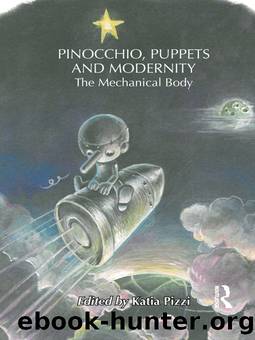Pinocchio, Puppets, and Modernity by Pizzi Katia;

Author:Pizzi, Katia;
Language: eng
Format: epub
Publisher: Taylor & Francis Group
Published: 2012-06-15T00:00:00+00:00
It is not difficult to understand how non-figurative or âabstractâ thought, which almost eludes grounded representation, might precede the inception of a painting. Yet this may also be the case for the writer who, previous to the actual work of writing may form a loose and barely representable âmental imageâ of his or her tale, which is just as likely to be visual as linguistic, if it can be described at all, and which originates in the writerâs mind long before it is ever manifest in type. This prefigural image of the âstoryâ may be quite different from the final text but may nevertheless remain in the memory of the writer. For both the painter and writer this intuited internal âimageâ cannot ever be fully replicated; in attempting to capture the image, at least in a fragmented form, a narrative structure emerges for the writer. This is perhaps particularly clear in the episodic structure of Collodiâs tale since each segment stands alone, thus giving the impression of a series of tableaux as well as the âspacesâ between them; such episodic stories also reveal the process of transformation from idea to final work more clearly, since the process of their construction is laid bare. Furthermore, both in the image of the fireplace and the storyâs image of the transformation of a log into a boy, Collodi seems almost to have written into his story this very gap between the âideaâ or mental image and the final, completed tale. The Adventures of Pinocchio, I would argue, is in fact a story about the creative process.
In the same way, a painter might move between a series of unwanted or âincorrectâ images in his or her commitment to what cannot be found or represented, so what is actually seen in the pictures, perceived almost as peripheral by the painter, may not be as important as what cannot be seen and which forms the heart of the process. The narrative arc here might then be considered as the relationship between the patch of paint and the whole of the picture, in other words, the relationship between the process of painting and the images that emerge as products of this process. This is a way of understanding painting that subverts the notion of the integrity of the individual work so central to traditional aesthetics, especially where we consider the âreal workâ to lie in the gaps between the actual works produced, an approach that is central to my own painting practice. In closely looking at the developing theoretical and conceptual concerns of the Macchiaioli painters, one can see how the relationship between the patch and the whole is often stretched to the limit. In this fragmented limit, it is as if the world is about to fall apart, as in the tension between unity and disparity, centre and periphery. Furthermore, this is not only an issue for painting; in these tensions, as we shall see, we find an exact reflection of the political situation of the time.
Download
This site does not store any files on its server. We only index and link to content provided by other sites. Please contact the content providers to delete copyright contents if any and email us, we'll remove relevant links or contents immediately.
4 3 2 1: A Novel by Paul Auster(11788)
The handmaid's tale by Margaret Atwood(7447)
Giovanni's Room by James Baldwin(6808)
Asking the Right Questions: A Guide to Critical Thinking by M. Neil Browne & Stuart M. Keeley(5356)
Big Magic: Creative Living Beyond Fear by Elizabeth Gilbert(5351)
Ego Is the Enemy by Ryan Holiday(4957)
On Writing A Memoir of the Craft by Stephen King(4662)
The Body: A Guide for Occupants by Bill Bryson(4583)
Ken Follett - World without end by Ken Follett(4443)
Bluets by Maggie Nelson(4261)
Adulting by Kelly Williams Brown(4232)
Eat That Frog! by Brian Tracy(4149)
Guilty Pleasures by Laurell K Hamilton(4116)
White Noise - A Novel by Don DeLillo(3829)
The Poetry of Pablo Neruda by Pablo Neruda(3815)
Fingerprints of the Gods by Graham Hancock(3738)
Alive: The Story of the Andes Survivors by Piers Paul Read(3730)
The Book of Joy by Dalai Lama(3697)
The Bookshop by Penelope Fitzgerald(3619)
